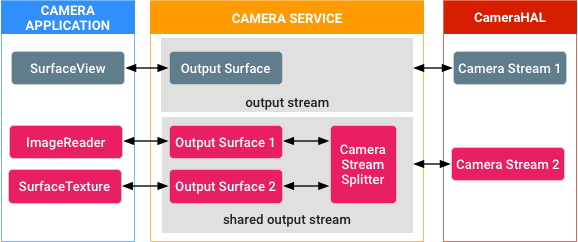ฟีเจอร์นี้จะแนะนำชุดเมธอดที่ช่วยให้ไคลเอ็นต์กล้องเพิ่มและ นำพื้นผิวเอาต์พุตออกแบบไดนามิกได้ในขณะที่เซสชันการจับภาพทำงานอยู่และ การสตรีมกล้องกำลังดำเนินอยู่ เอาต์พุตใหม่สามารถแมปกับสตรีมกล้องที่แชร์ ที่ผู้ใช้เลือกได้ หลังจากเพิ่มแพลตฟอร์มแล้ว คุณจะนำออกได้ทุกเมื่อ
แนวคิดทั่วไปคือการแชร์บัฟเฟอร์ที่เชื่อมโยงกับสตรีมของกล้องหนึ่งๆ ภายในพื้นผิวเอาต์พุตหลายรายการ ตัวนับการอ้างอิงภายในจะติดตามบัฟเฟอร์ เมื่อบัฟเฟอร์พร้อมสำหรับการประมวลผลเพิ่มเติมในฝั่งผู้ใช้ เมื่อผู้ใช้ทั้งหมดทำงานที่เกี่ยวข้องเสร็จแล้ว ระบบจะนำบัฟเฟอร์ออกจากคิวและ พร้อมใช้งานสำหรับกล้อง

รูปที่ 1 การแชร์บัฟเฟอร์
รูปที่ 1 แสดงสถานการณ์ตัวอย่างที่บัฟเฟอร์ซึ่งประมวลผลโดยสตรีม 2 ของกล้อง จะได้รับการแนบและยกเลิกการแนบแบบไดนามิก มีการนับการอ้างอิง และจัดการ โดยคอมโพเนนต์ตัวแยกสตรีมภายในสตรีมเอาต์พุตที่แชร์โดยเฉพาะภายใน บริการกล้อง
ตัวอย่างและแหล่งที่มา
การใช้งานหลักของฟีเจอร์นี้อยู่ในโมดูล
Camera3StreamSplitter
ดูเอกสารประกอบเกี่ยวกับฟีเจอร์นี้ได้ในการอ้างอิงสำหรับนักพัฒนาซอฟต์แวร์
การใช้งาน
ไม่จำเป็นต้องติดตั้งใช้งานในฝั่ง HAL ของกล้อง เนื่องจากฟีเจอร์นี้ ติดตั้งใช้งานในฝั่งเฟรมเวิร์ก
การตรวจสอบความถูกต้อง
การติดตั้งใช้งานของคุณต้องผ่านกรณี CTS ที่ครอบคลุมฟีเจอร์นี้จากโมดูล MultiViewTest และไลบรารี JNI แบบเนทีฟสำหรับ API แบบเนทีฟ

